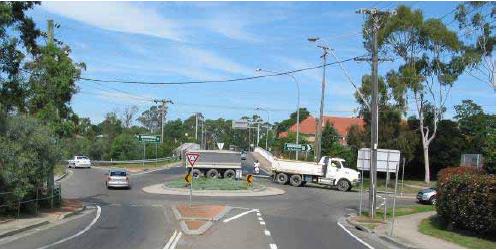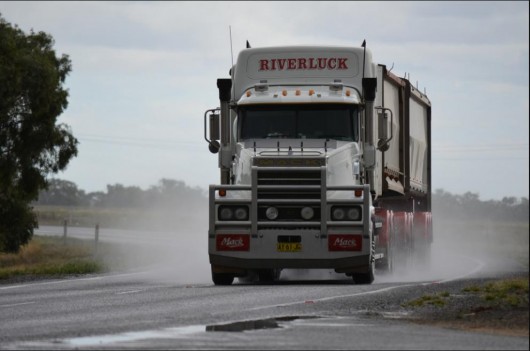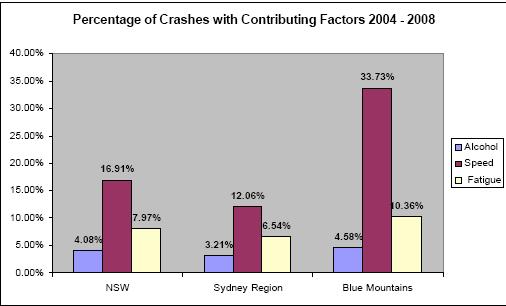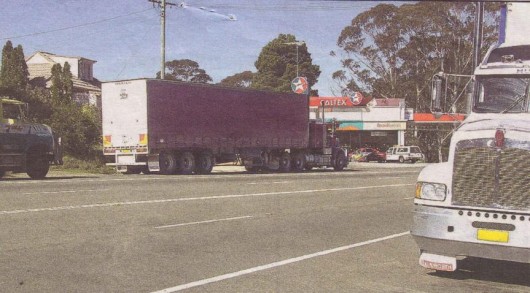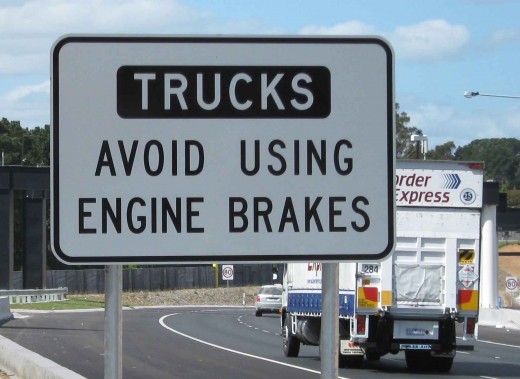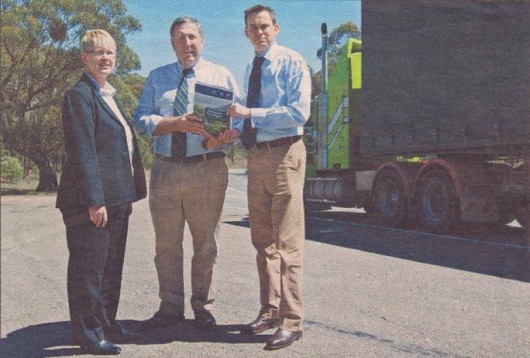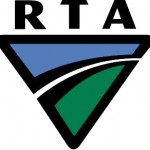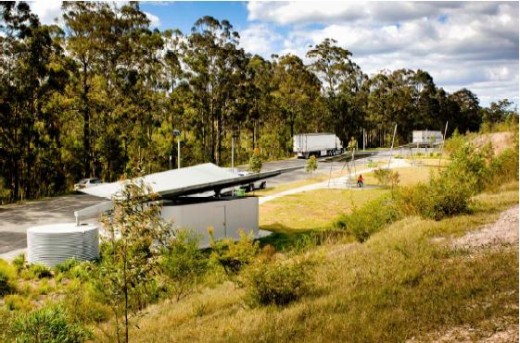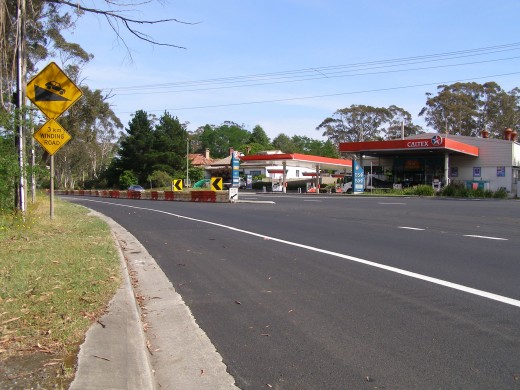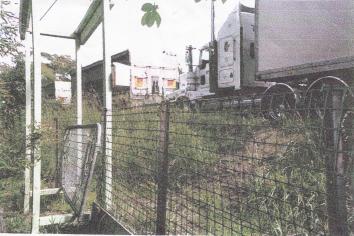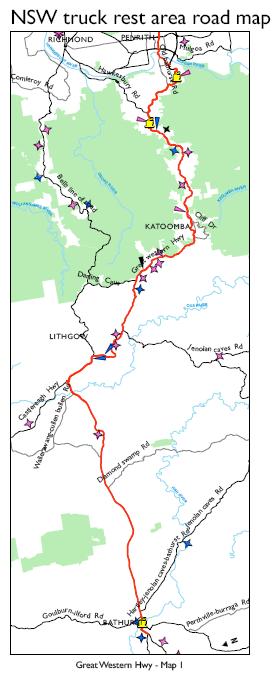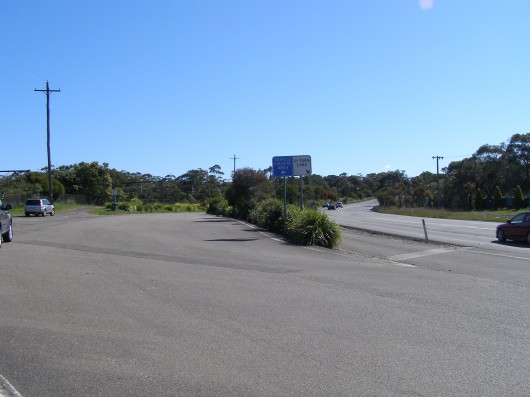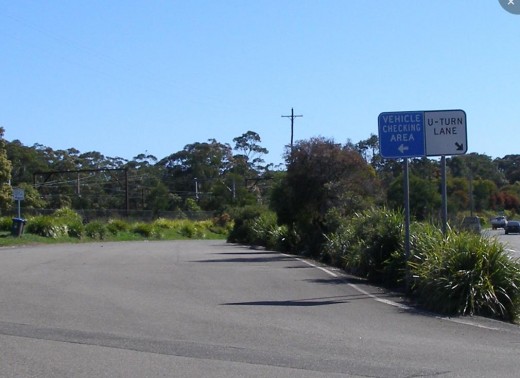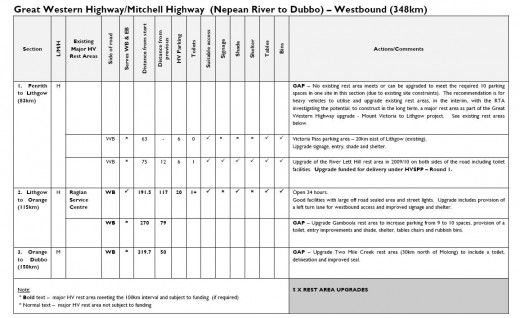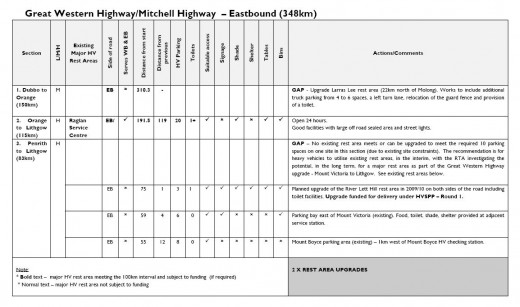Speeding truck cowboys along Hawkesbury Road
Sunday, May 26th, 2013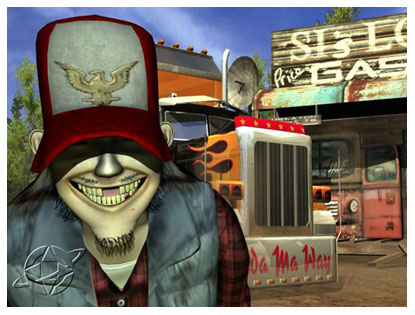 Ada Ma Way!
Ada Ma Way!
.
The New South Wales Government’s dictatorial roads department, the RTA-come-RMS, has again kowtowed to the trucking lobby by deciding in its infantile wisdom to remove centre double lines from the Hawkesbury Road through the Blue Mountains west of Sydney, so that big sand trucks with trailers (basically ‘B-Doubles‘) can hog both sides of the highway.
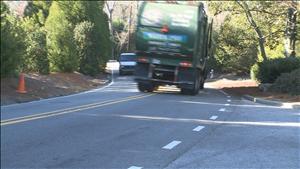 Looka Me Looka Me Looka Me!
Looka Me Looka Me Looka Me!
.
The idiots in the fancy new RTA-come-RMA headquarters in Parramatta want no restrictions on truck-length, no speed restrictions for these trucks along Hawkesbury Road – the bigger trucks the better, God Damn!
.
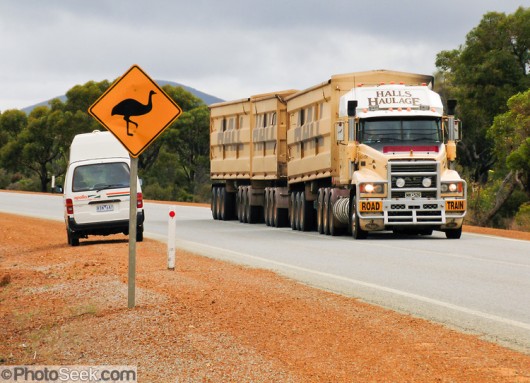 Strategy to avoid a B-Double
An Outback vernacular joke, not so funny…
Strategy to avoid a B-Double
An Outback vernacular joke, not so funny…
.
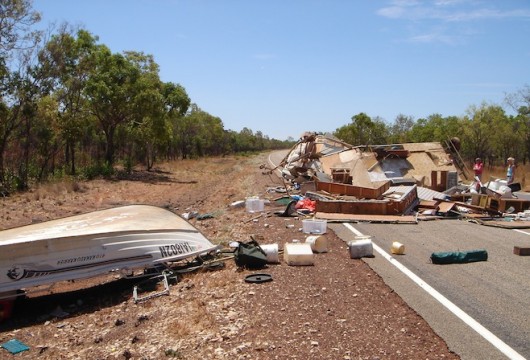 Outback Crash
Often the End of Everyone’s Story!
Outback Crash
Often the End of Everyone’s Story!
.
It’s a Northern Territory Outback Approach – unlimited speed and road trains – despite Hawkesbury Road winding tightly down the mountain at Hawkesbury Heights and passing through residential areas between Springwood and Richmond.
.
Winmalee ain’t trucking Tennant Creek!
.
According to Hawkesbury Road residents typically 90 tipper trucks with dog trailers (basically B-Doubles) hoon along the road daily.
In late 2012, the RTA-come-RMS removed the centre line marking on four hairpin bends at Hawkesbury Heights so that bigger trucks can cross the center of the road without crossing over centre double lines because the double lines have been painted over.
No centre lines, no road centre, see, just like Mount Panorama! No speed cameras, no police patrols, speeding cowboy truckers out of control. Car, motorbike and pedestrian traffic are just collateral damage.
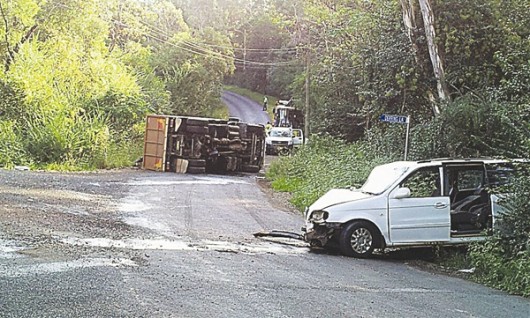 Bugger!
Bugger!
Truck rollover along Mill Road at Kurrajong in the Blue Mountains
Cowboy Trucker going too fast – nuh.[Source: Photo by Top Notch Video, in article ‘Lucky Easter accident escape’, 20120412, by Cerise Burgess, journalist, Hawkesbury Gazette, ^http://www.hawkesburygazette.com.au/story/273890/lucky-easter-accident-escape/]
.
The local Blue Mountains Council has rightly branded the RTA-come-RMS decision to remove these double centre lines as “absolutely insane”‘, “ridiculous” and “plain criminal” at its councillor meeting on 23rd April 23 2013. Councillor Brendan Christie stated, “I just think it is completely ridiculous that six bureaucrats from the RMS sat down for a nice lunch and this is all they could come up with.”
 Blue Mountains Council’s delegated Local Traffic Committee: Minutes of Meeting 20130326
Blue Mountains Council’s delegated Local Traffic Committee: Minutes of Meeting 20130326
.
Two years ago in 2011, the Blue Mountains Council reported on a Road Safety Action Plan. The report identified that:
<<the Blue Mountains has almost triple the amount of speed related crashes than the Sydney Region. Our rate of 33.73% is almost double that of the rate of NSW. This makes reducing speeding on our roads a clear road safety priority for the Blue Mountains community.>>
The report also identified trucks as a key issue:
<<The Blue Mountains has a significantly higher proportion of trucks involved in crashes than the Sydney Region, Western Sydney or NSW.
Over a five year period, light trucks constituted 9.53% of crashes in the Blue Mountains. This can be compared with 7.85% in Sydney, 8.31% in Western Sydney and 8.67% in New South Wales as a whole. The Blue Mountains also experienced significant increases in crashes involving trucks over the last five years.>>
.
>Read Plan (PDF, 450kb)
.
Yet at the same time, the Blue Mountains Council is similarly embracing more trucks transiting through Blue Mountains by planning a new truck route through native bushland habitat and over the headwaters of Fitzgerald Creek and carved through critically endangered Sydney Turpentine Ironbark Forest in protected Deanii Reserve.
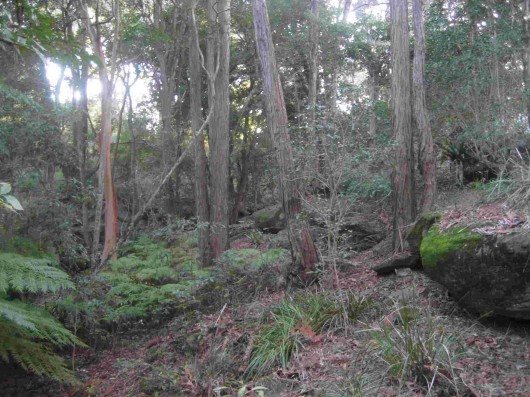 Example of a Sydney Turpentine Ironbark Forest
[Source: ^http://www.georgesriver.org.au/Riverkeeper-Photo-Gallery.html]
Example of a Sydney Turpentine Ironbark Forest
[Source: ^http://www.georgesriver.org.au/Riverkeeper-Photo-Gallery.html]
.
The Council has already spent $77,000 on a study to consider possible route options for a truck link road between Hawkesbury Road and the Great Western Highway at Valley Heights. The preferred route necessitates massively increasing the road weight limit, creating a two-lane, three-span bridge 35 metres above Fitzgerald Creek with a total the project construction cost of $26 million, all to encourage more trucks through the Blue Mountains.
Borrowing the same mealy-mouthed spin as the RTA-come-RMS, the Council’s consultants try to justify the new road would “improve traffic flow and reduce delays.” No doubt its environmental impact statement would be conjured up by darkside ecologists to pretend the road works and bridge works would cause minimal impact to endangered ecology.
The initial council study will go on public exhibition soon with a report back to council in August 2013. We shall be ready to rip the EIS apart, or will it be watered down to another Review of Environmental Effects as per usual?
.
[Source: ‘Springwood link road plan’, 20130508, by Shane Desiatnik, journalist, Blue Mountains Gazette, ^http://www.bluemountainsgazette.com.au/story/1486914/routes-named-for-springwood-link-road-plan/].
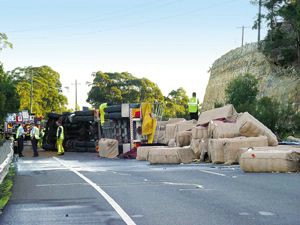 Truck rollover in the Blue Mountains April, 2005
RTA-come-RMS is giving tacit approval for truckers to use excessive speed and ignore common safety measures.
Truck rollover in the Blue Mountains April, 2005
RTA-come-RMS is giving tacit approval for truckers to use excessive speed and ignore common safety measures.
.
The RTA-come-RMS is the handmaiden to the truck industry and has allowed Hawkesbury Highway to become a trucking cowboy corridor.
The Bells Line of Road is just a bad:
Somewhere in the Blue Mountains there is a truck collision or rollover a week. The trucking menace is out of control and these are the bureaucrats responsible – New South Wales Premier Barry O’Farrell and his Roads Minister Duncan Gay.
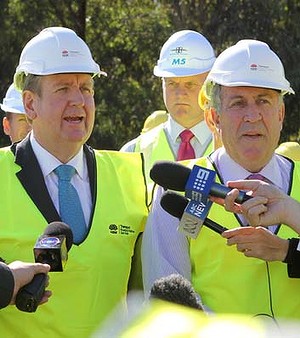 Premier Barry O’Farrell (left) and Roads Minister Duncan Gay
Handmaidens of Trucking
Premier Barry O’Farrell (left) and Roads Minister Duncan Gay
Handmaidens of Trucking
.
Local residents and ordinary users of the Hawkesbury Road are intimidated by these trucking cowboys speeding, hogging the road and tailgating like their on a speedway circuit.
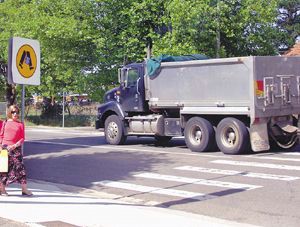 Blackheath, Blue Mountains, already a statistical victim
Betty Dowdell of Blackheath, 16 Dec 2008, rest in peace
Your memory is not lost.
Blackheath, Blue Mountains, already a statistical victim
Betty Dowdell of Blackheath, 16 Dec 2008, rest in peace
Your memory is not lost.
.
Drivers on the bends of Hawkesbury Road have raised concerns about the serious risks of heavy vehicles crossing to the wrong side of the road as they negotiate the narrow corners. The Roads and Maritime Service removed the centre lines on the bends late last year which residents say has only increased the problem.
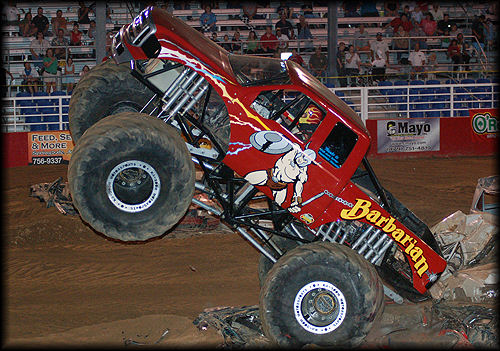 Trucker Wet Dreaming
Trucker Wet Dreaming
.
With four schools on the 10km road, driver safety is paramount both on the Winmalee stretch and also for those people driving down from the Mountains via the bends. According to local politicians, the solution would be for a proper review of the road by the RTA-come-RMS, with a view to enforcing the road rules, including a return to the centre lane markings on the bends and looking at other engineering options.
But many local residents have had enough and are demanding a complete ban trucks from driving on Hawkesbury Road which would mean it would no longer be gazetted as a State Route.
.
Barry, unhitch from the greedy Trucking Lobby
Support the safety concerns of Residents
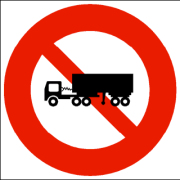 No Articulated Trucks on Hawkesbury Road
No Articulated Trucks on Hawkesbury Road
No Trucking Shortcuts!
.
[Source: ‘Hawkesbury Road residents driven round the bend’, 20130424, by Damien Madigan, editor, The Blue Mountains Gazette, ^http://www.bluemountainsgazette.com.au/story/1454002/hawkesbury-road-residents-driven-round-the-bend/].
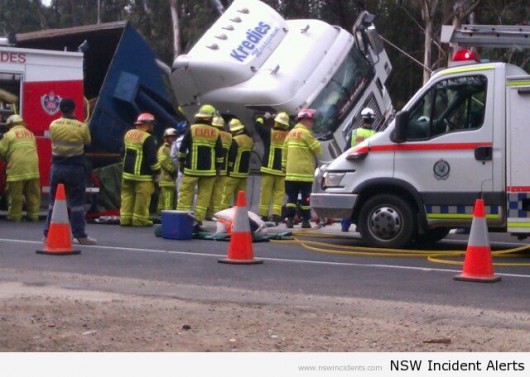 Kredies Trucking speeding down Victoria Pass, 5th December 2011
Kredies Trucking speeding down Victoria Pass, 5th December 2011
.
<<A truck driver has been airlifted to hospital with suspected spinal injuries, and a major cleanup operation has been undertaken following a truck overturning on Mount Victoria Pass this afternoon (5 December 2011).
Emergency Services were called to the bottom of Mount Victoria Pass (Great Western Highway) just after 2:30pm today following reports an eastbound semi-trailer carrying scrap metal had rolled onto the concrete divider, leaving the driver trapped in the cabin.
Several Fire and Rescue NSW crews, Police Rescue, an Ambulance and a rescue helicopter responded to the scene. Rescue crews freed the driver about 4:45pm before he was airlifted to hospital suffering suspected spinal injuries.
The Great Western Highway has been closed for several hours while a clean up and salvage operation is underway with debris scattered across the roadway. The RTA has advised traffic is being diverted into the Darling Causeway with eastbound motorists being advised to use Chifley Road (Mort St) and the Darling Causeway as an alternative route.>>
.
[Source: ‘Truck Overturns at Mount Victoria’, 20111205, by NSW Incident Alerts, ^http://news.nswincidents.com/2011/12/05/traffic/persons-trapped/truck-overturns-mount-victoria/].
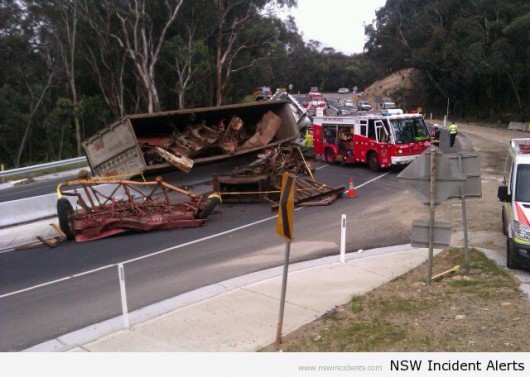 Speeding Truck Overturns down Mt Victoria Pass, 3rd August 2011
Two truckers dead
The pass has been there and steep for a long time – nothing new.
Speeding Truck Overturns down Mt Victoria Pass, 3rd August 2011
Two truckers dead
The pass has been there and steep for a long time – nothing new.
.
<<Two men have been crushed to death inside the cabin of a truck in the Blue Mountains today. Police said the truck rolled and crashed into a barrier on the Great Western Highway, near the top of Victoria Pass, just after 10am. The two men were found dead inside the cabin. Their ages are unknown. One eastbound lane of the highway is expected to be closed for some time while police investigate.>>
.
[Source: ‘Two killed in Blue Mountains truck crash’, 20110803, by Georgina Robinson, Sydney Morning Herald, ^http://www.smh.com.au/nsw/two-killed-in-blue-mountains-truck-crash-20110803-1iaqu.html].
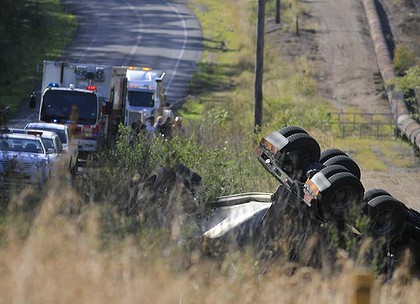 It’s like the approach to Bagdad after Allied Forces’ Battle of Bagdad in 2003
It’s like the approach to Bagdad after Allied Forces’ Battle of Bagdad in 2003[Source: ‘F3 accident outpost clears way for network of depots’, 20111027, Sydney Morning Herald, ^http://smh.drive.com.au/roads-and-traffic/f3-accident-outpost-clears-way-for-network-of-depots-20111026-1mk7i.html]
.
Footnote
.
Again, we didn’t have to wait long to learn about yet another dangerous trucking cowboy in New South Wales.
In Sydney’s outer north this morning, a truck side-swiped a school bus and didn’t stop.
The small school bus was travelling along Bay Road at 9 am at Berrilee, when the bus driver was forced to swerve to avoid a head-on collision with the truck over the centre lines.
In avoiding the collision, the bus driver scraped along a rockface alongside the left hand side of the narrow section of Bay Road. Four bus windows were smashed, and seven children on the bus suffered minor cuts from the smashed glass. Two of them were taken to hospital. The truck driver drove on (another hit and run) following the incident and yet police decided not to contemplate pursuing criminal charges.
Unbelievably the police are sight unseen self-excusing the trucker for ‘perhaps’ not realising the damage, because of some fabricated personal presumption that the truck was too big for the driver to notice. “We don’t think he even realised something had gone wrong” the police spokesman said.
Was this comment correctly reported by the media? If so, how does the police spokesman know? Does it take a child to die for these police to treat seriously the near fatality of children on a supposedly safe school bus?
If so, these police should state this presumption to the faces of the children’s parents and see what response they get for excusing dangerous trucking behaviour endangering the lives of their children.
If so, then these police are ignorant of what could have happened, of the likely trauma experienced by both bus driver and the children who will never forget this incident that could have ended their lives. These police seem to nonchalantly care nothing for road safety or for proactive policing.
‘She’ll be right reckless trucking‘ is unacceptable and here we record yet another trucking cowboy excused by police, until next time when an innocent road user is killed.
Not good enough!
.
[Sources: ‘Children injured in school bus crash at Berrilee in Sydney’, 20130529, ABC News, ^http://www.abc.net.au/news/2013-05-29/three-children-injured-in-school-bus-crash/4719814?§ion=news; and ‘Sydney school bus crash injures children, 20130529, by AAP, ^http://www.news.com.au/breaking-news/national/children-hurt-in-sydney-bus-crash/story-e6frfku9-1226652814870] . 2005: Another B-Double truck slammed into the rear of a school bus while speeding in fog at 8:30 am (school transit time) in country Victoria. About 20 primary school children were lucky not be killed as the back of a school bus was ripped off in the collision near Ballarat.
[Source: Photo by Craig Sillitoe, in article: ‘Bus crash students lucky to be alive’, 20050513, by Adam Morton, The Age, Victoria,
^http://www.theage.com.au/news/National/Bus-crash-students-lucky-to-be-alive/2005/05/13/1115843345721.html]
2005: Another B-Double truck slammed into the rear of a school bus while speeding in fog at 8:30 am (school transit time) in country Victoria. About 20 primary school children were lucky not be killed as the back of a school bus was ripped off in the collision near Ballarat.
[Source: Photo by Craig Sillitoe, in article: ‘Bus crash students lucky to be alive’, 20050513, by Adam Morton, The Age, Victoria,
^http://www.theage.com.au/news/National/Bus-crash-students-lucky-to-be-alive/2005/05/13/1115843345721.html]
